REDUCE, REUSE, RESELL
How to turn your old clothes into cash
THE POWER OF LOVE
The journey that led one student to reconcile with his dad
A SAFE SPACE
Meet the student group fighting for undocumented rights
SPRING 2019
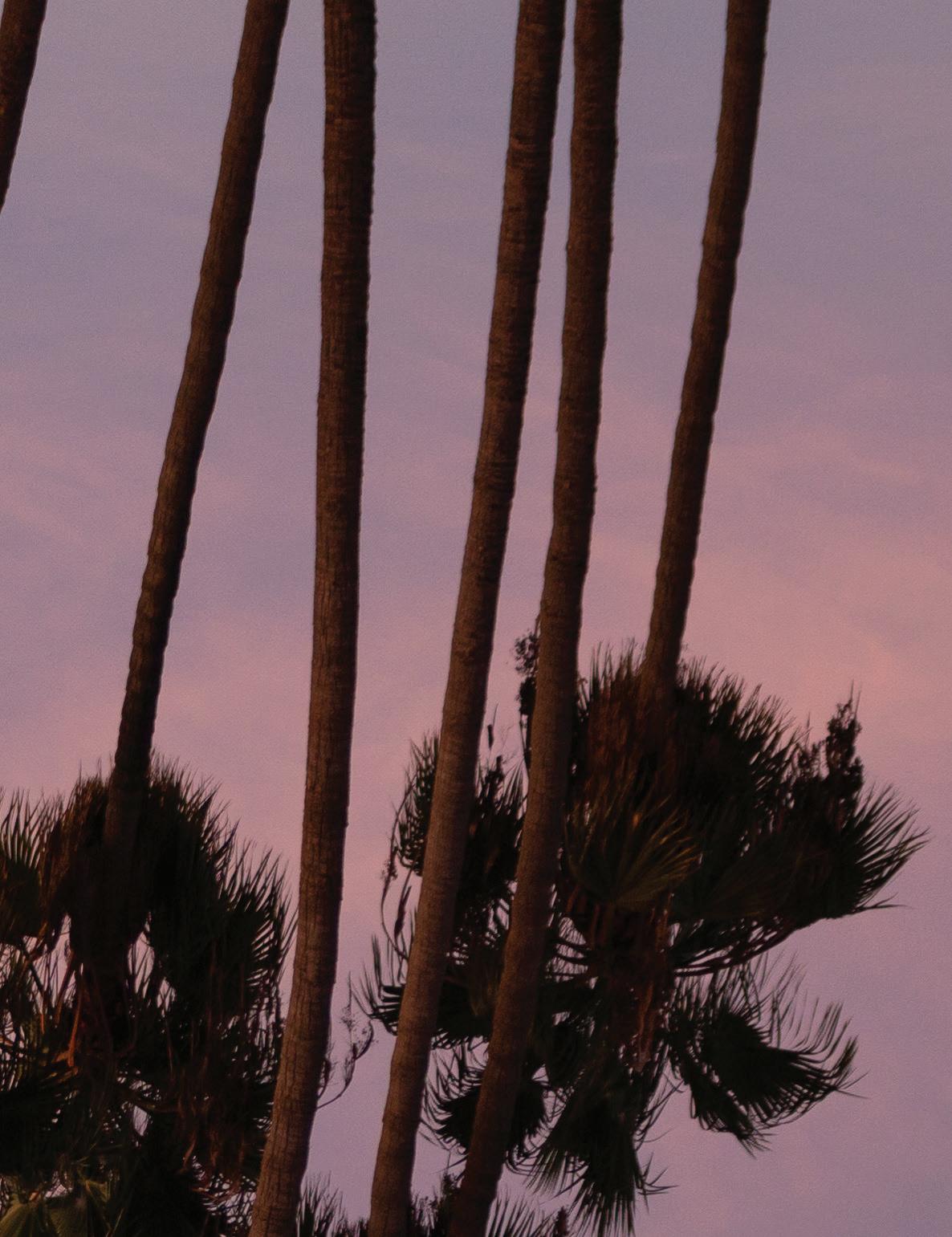
LIFESTYLE • COMMUNITY •
LONG BEACH
INSPIRATION








FREE Gift when you open a Free Checking Account at Southland Credit Union Long Beach!* *While supplies last. Membership subject to eligibility.
3
LB INSIDER
Take a day-trip to some off-the-beaten-path spots in Huntington Beach, try inventive concha sandwiches, discover your new favorite mocktail, escape on a hike with fellow students, and more.
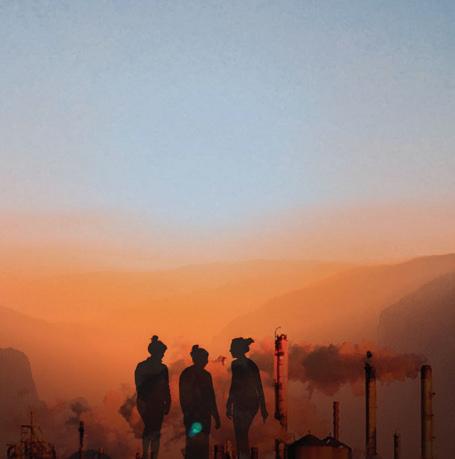

20
IN WITH THE NEW, OUT WITH THE OLD BY
LOLA OLVERA
In need of fast cash or an eco-friendly way of getting rid of old clothing? Learn how to make a few extra bucks by selling to local secondhand shops.


22
LOVE CAN LIFT THE BROKEN BY
PETE ESCOBAR
After years of neglect, one student rejected the possibility of having a relationship with his dad. But life had an unexpected way of showing him that the love between father and son should never be underestimated.
24
SUPPORT IN TIMES OF NEED BY
ISAURA ACEVES
In light of today’s political climate surrounding immigration, a student organization is stepping up to reassure undocumented students that they are not alone.
26
PHOTO ESSAYS
From a photography collection in vivid colors to a black-and-white photo essay featuring student artists, we showcase work by DIG staff.
32
QUICK QUESTIONS WITH JUSTINA KING
We lobbed a few questions at the freshman point guard for the Long Beach State women's basketball team.
SPRING 2019 1
TABLE OF CONTENTS
FREE a Account Union Beach!*
Ihave always found change enigmatic in the way that it is both positive and negative. Sometimes, it is a welcome wave of relief. In other cases, it is a dreaded specter looming over us.
Even the most adventurous among us fall back on our habits and get caught up in the grind of everyday life once in a while. If nothing else, change is disruptive.
For years, I have had a quote hanging on my wall that reads, “When you change the way you look at things, the things you look at change.” It is encouraging to think that, even when it seems I no longer have control of my circumstances, I always have control of my perspective.
With the beginning of a new season and new semester, most of us are experiencing a healthy mix of changes — weather, schedules, jobs, friends.
Some of us are feeling overwhelmed by the changes life has thrown at us. Our plans and routines have been shaken up, and life has been turned upside down by the unexpected. Though it may feel like you have lost your grip on the steering wheel, don’t give up. Though it may
Editor-In-Chief
Gillian Smit
Art Director
Tracy Keller
Online Editor
Leslie Leon
Social Media Editor
Diana Martinez
Assistant Online Editors
Annika Brandes
Delaney Tran
Assistant Social Media Editors
Niyah Maldonado
Myra Pimentel
Photo Editor Andres Tolentino
Features Editors
James Chow
Jillian Gronnerud
Cheantay Jensen
Alexa Moreno
Brooke Torrez
Natalie Wallace
seem impossible, search for a new point of view. When we change our perspective, our greatest challenges can become opportunities for growth.
Others of us are looking to make changes in our lives. Change may seem daunting and difficult, but it doesn’t have to be. Plan that much needed vacation, whether it is an unforgettable spring break or a day trip in Long Beach. Change up your wardrobe by following our guide to selling used clothing. Look at something familiar from a new point of view like the photograph on the cover of this issue. Seek out stories, art and entertainment that inspire you. Try new foods, spend time outdoors, and let your creativity take you places you never expected.
At DIG MAG, we are looking forward to more exciting opportunities to share our perspective with you.
EDITOR-IN-CHIEF
Faculty Advisers
Robin Jones
Gary Metzker
Jennifer Newton
Advertising Account Executives
Clayton Hutton
Andrew Pardo
FIND US ONLINE! digmagonline.com
Instagram: @dig.mag
Twitter: @digmag facebook.com/digmag
Submissions: digmageditor@gmail.com
Advertising: clayton.digmag@gmail.com andrew.digmag@gmail.com
ON THE COVER:
DIG MAG is the insider’s guide to Long Beach for the Long Beach State community, inspiring readers to immerse themselves in the Long Beach lifestyle through inthe-know stories about the latest in food, arts, entertainment and culture; in-depth features about people and trends on the campus and in the city; poetry, fiction and literary journalism written by students; and beautiful photography and design. Published by the Department of Journalism and Public Relations at Long Beach State, it is produced entirely by students.
California State University, Long Beach, 1250 Bellflower Blvd., LA-4 203, Long Beach, CA 90840-4601
© DIG and 49er Publications Board 2019
DIG MAG is a publication of the DIG and 49er Publications Board.
An excerpt from SATURDAZED, a photography collection by Andres
Tolentino, DIG MAG photo editor. See other photos from the book on page 26.
2 SPRING 2019
A Garden Retreat
BY ROSLIN OJEDA
In need of a little relaxation? Check out the Earl Burns Miller Japanese Garden on campus. It hosts various events year-round for students and visitors. On Tuesdays and Fridays from 8 a.m. to noon, you can join a Volunteer-Docent Program, where volunteers and Long Beach State students lead tours of the garden. Sunday Funday offers different activities throughout the day, including Browse a Book and Rake Away Stress, where visitors can explore books on Japanese culture for children and adults or unwind by raking miniature tray rock gardens. The garden is free to students, faculty and staff and is open Tuesday through Friday, 9 a.m.-4 p.m. and Sunday, noon-4 p.m.

SPRING 2019 3
PHOTO BY JACOB YBARRA
Where to Next?
Huntington Beach Day Trip
STORY AND PHOTOS BY CAITLIN TREBIL
TKO Records
21405 Brookhurst St., Huntington Beach
Tucked away in the corner of Brookhurst Plaza, TKO Records could easily be overlooked. However, you can’t miss the sign of Johnny Ramone that leads to the entrance of the store. The store has old vinyl, new albums, reissues, band tees; it’s a music lover’s dream!


Huntington Beach isn’t nicknamed Surf City USA for no reason. It’s the go-to town for catching some waves and grabbing food at Banzai Bowl or Sugar Shack Cafe in the morning and cruising down PCH in the evening. Although it's known for its beach, surf and Main Street, there’s more to this town when you venture away from these typical destinations. If you drive down Beach Boulevard through HB, there’s Bahama Bucks, which has the best shaved ice, the Assistance League, where you can find thriftshop deals, and The Donuttery for specialty donuts — along with these five spots. Whatever path you choose, the trip will be worthwhile.
AoSA Coffee
16821 Algonquin St., Huntington Beach
Looking to get some caffeine? Huntington Beach is full of small coffee shops, but AoSA is its hidden gem. Locals can be found doing work or hanging out inside the cozy rustic interior. There’s a variety of different handcrafted drinks, as well as acai bowls and brunch items.

4 SPRING 2019
Bolsa Chica
Ecological Reserve
Pacific Coast Highway, Huntington Beach
The Bolsa Chica Ecological Reserve, otherwise known as Bolsa Chica Wetlands, provides a perfect alternative to the busy beach. There’s a variety of birds, marine life and native plants to find and admire. It’s a great place to meet your friends and go for a hike.


Pacific City
21010 Pacific Coast Highway, Huntington Beach
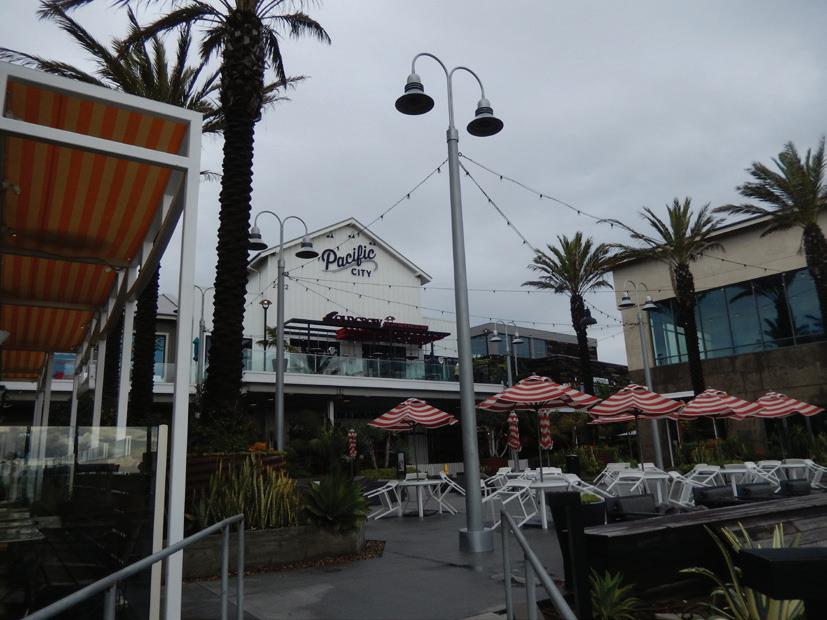
Recently added to the beach town, Pacific City is a modern take on Huntington Beach. Packed with restaurants, small businesses and luxury shopping, it has something that everyone can enjoy. Don’t forget to grab some ice cream at Hans’ Homemade Ice Cream or lemonade at Lemonade Restaurant and sit back to watch the waves and the beach views.
Tree Branch Cider House
6953 Warner Ave., Huntington Beach
End the day by grabbing a drink at the Tree Branch Cider House. There are plenty of options, from ciders, beers and meads to flights of six or eight. Although it doesn’t have a full kitchen, there are snacks available and visitors are more than welcome to bring their own food.

SPRING 2019 5
Students Vs. Faculty
Going to the NCAA Men’s Basketball Final Four in San Antonio. Had the best barbecue of my life and got to see some good games!
- LEXI REED, CHEMICAL ENGINEERING MAJOR
My favorite was sophomore year. I was able to finally visit Walt Disney World in Florida for the first time and attend all four parks and one of their water parks.
- KALIA WHITFIELD, RECREATION MAJOR
I went to San Francisco, and my friends and I got stuck on some cliffs and had to be rescued by the coast guard. Oops.
- KAS SANCHEZ, ART MAJOR
Going to Yosemite and Rosarito in one week. Then losing my phone (which had my ID) at Papas and Beer and getting lost and separated from my group. But I was able to talk like a local and found my way back to my hotel in Las Gaviotas.
- BENJAMIN FLORES, ASTRONAUTICAL ENGINEERING MAJOR
WHAT WAS YOUR MOST MEMORABLE SPRING BREAK?
The spring of my senior year in college at CSULB, I went with my roommate to Palm Springs. We had spa treatments, hung out by the pool and ordered poolside service. It was relaxing, felt special, and I was motivated to finish the semester and graduate. I learned it’s really about a vacation break and coming back rejuvenated.
- ELIZABETH SANCHEZ, JOURNALISM PROFESSOR
I had never been to New York City before, and my husband was there working at the New York Auto Show. He invited me to go for the week, so we spent a week in New York. It was memorable because I had never been. I was blown away by everything about it. It’s so different from here.
- KAYLA DELANO, KINESIOLOGY PROFESSOR
Students Faculty
6 SPRING 2019
Bottoms Up All Hail the Mocktail
 BY JORGE PANIAGUA
BY JORGE PANIAGUA
Designated drivers rejoice! Long Beach is home to some of Southern California's highest-rated bars; however, if you're looking for a fun night in the city without the laundry list of regrets in the morning, mocktails are the way to go. Most Long Beach bars provide non-alcoholic beverages, yet there are a few places that really get crafty with their sober-friendly drinks. You'll get to enjoy the flavors of a cocktail without the booze.


Roxanne's Cocktail Lounge & Latin Grill
1115 E. Wardlow Road, Long Beach roxanneslounge.com
The great thing about this lounge is that not only can you grab some intricate mocktails, but you can also enjoy delicious Latinx bites with an American twist, like Gouda nachos, pastrami quesadillas and crispy chicken taquitos. Pair some fried plantains with a Roxy Smash with a vodka substitute — white grape juice or apple cider should suffice. You’re looking at a delightful alcohol-free beverage featuring melon, lemon, cucumber and simple syrup.
The Exhibition Room
1117 E. Wardlow Road, Long Beach
theexhibitionroom.com
This speakeasy in Long Beach is known for its intimate, vintage setting, enjoyable live music and crafty mixologists. Although the bar is famous for its strong alcoholic beverages, some of the drinks can be converted into sober refreshments. Order a Mango Mule, the Moscow Mule’s fruity, and alcohol-free, counterpart. The drink includes cucumber slices, honey syrup, mango puree, fresh lime and ginger beer: all fiesta without the hangover.
Hamburger Mary's
330 Pine Ave., Long Beach
hamburgermarys.com
This LGBTQ+ bar and grill is famous for providing Pine Avenue with vibrant, Queer-friendly fun. It’s widely known for its interactive drag show experiences, lively dance floor and, of course, delicious drinks. However, if you’re looking to dance the night away, rather than drink yourself into oblivion, this locale has got you covered. “The best mocktails are the creative ones,” says Javier Pacheco, former Hamburger Mary’s bartender. “It’s all about bold flavors and the delivery of them.” Pacheco recommends a POM spritz: POM Wonderful juice, sparkling water and crushed ice garnished with pomegranate seeds.
SPRING 2019 7
ROXANNE'S LOUNGE
Nature Is Calling
In the Heights
STORY AND PHOTOS BY ZACKARY MEJIA AND JILLIAN GRONNERUD
Schabarum Park offers natural beauty without leaving civilization behind.
Five hundred and seventy-five acres dedicated to nature and community make Schabarum Regional County Park the perfect escape for a day, or even a weekend, of outdoor fun and recreation. Located on the border of Hacienda Heights and Rowland Heights, this sprawling park is sure to have something for every visitor; there are miles of hiking and mountain biking trails, camping and picnic sites, sports facilities and even opportunities for horseback riding. Although there is a cash-only vehicle entrance fee on weekends and holidays, it is well worth the price to leave the city behind and explore the nearly 500 acres of undeveloped land in the park. Discover sweeping vistas, encounter curious wildlife and enjoy the restorative experience of spending time outdoors.

8 SPRING 2019
PACK A SNACK
Picnic areas are just some of the venues ideal for spending time with friends or family in Schabarum Park. There are individual and group picnic sites, amphitheaters that host occasional concerts in the park and free group exercise classes offered throughout the year. Visit the Park Programs dropdown menu on the website for the schedule of events each month.

TAKE A HIKE
Breathtaking views, like this one of the San Gabriel mountains visible from one of the trails, – are not uncommon throughout the more secluded parts of the park. Whether you’re doing a solo trek or hiking as a group, you’ll find that the dense vegetation and seasonal wildflowers provide beautiful scenery at any time of year. The park opens at 6 a.m. on weekdays and 7 a.m. on weekends, and remains open until 8 p.m. during spring and summer months.

HIT THE TRAIL
Trails of varying length and difficulty are scattered throughout the park. One of the most popular hikes is The Purple Sage and Powder Canyon Loop Trail, a 4.1-mile hike that is great for any skill level, accessible year-round, and dog-friendly (as long as the dogs are kept on a leash). Those looking for more of a challenge can continue onto the historic Juan Bautista De Anza National Historic Trail via connecting trails at the southern end of the park.
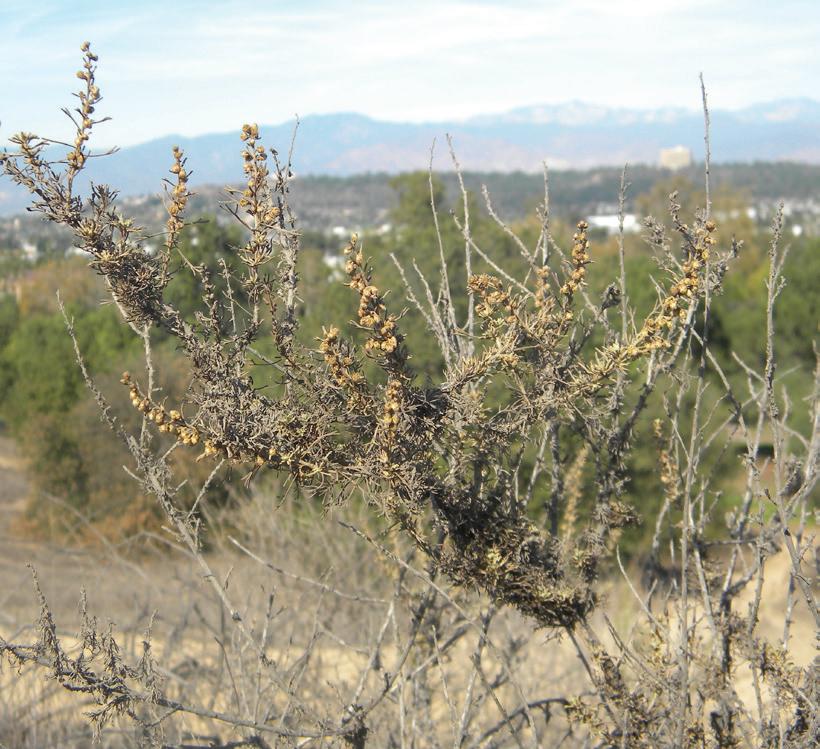
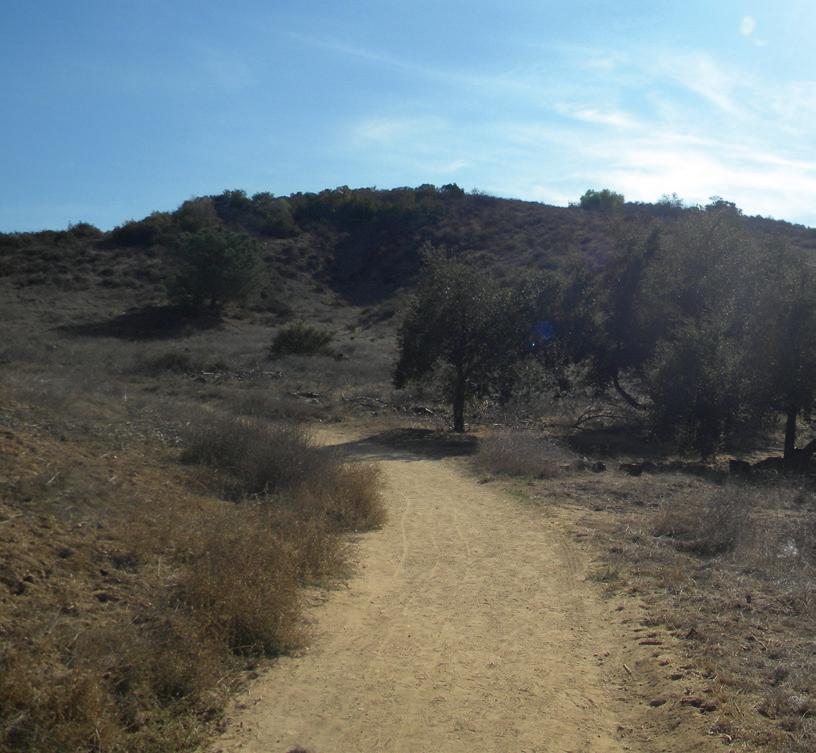
SPRING 2019 9
Hidden Figures
Keeping Cool
BY MARIA ISABEL CUBILLO
How one group of students is changing prosthetics for the better.
On a hot summer day or after a brisk walk, we may sense our body temperature rising. For people who wear prosthetics, temperature is an even bigger concern. Prosthetic liners can trap heat, making even light exercise unbearable. Rae-Jillian Rivera, a Long Beach State electronics engineering technology student who did research at the Veterans’ Affairs Hospital in Long Beach, had heard such complaints from amputees.
She did three years of research on the subject through the Research Initiative for Scientific Enhancement on campus, and she was presenting her findings at a Long Beach State TEDx social space when she met Calvin Leung, a marketing and management information systems major.
As a kid, Leung wanted to be a scientist and enjoyed reading science books. He continued to foster that interest during his college years by being part of the Engineers for a Sustainable World club. He saw a chance to merge his business skills with his interest in science during Rivera’s presentation.

10 SPRING 2019
TRANG LE
The pair teamed up to start Artemus Labs and decided to compete in Long Beach State’s annual Innovation Challenge, a competition for students to showcase their business ideas.
To round out their team, they recruited their friends to join. Kimberly Ventura, the company’s vice president of finance and engineering, is Rivera’s childhood friend. Nikki Escobar, vice president of design, met Rivera through the Filipino American Coalition, a student club.
Another team member, Anna Maria del Mundo, met Leung through a student club for management information system majors, and the two came to know each other better in the College of Business Incubator, which “weekly provides programming on business skills for teams that compete in the [Innovation] Challenge,” says Wade Martin, director of the Institute for Innovation & Entrepreneurship.
Together, the team created a breathable silicon sleeve that reduces movement and chafing between the residual limb and the socket of a prosthetic for lower limbs. Their invention won the top prize in the Innovation Challenge, an honor that came with $10,000 in seed funding and space, marketing, legal and accounting services.
Leung graduated in 2017, but the other four members of Artemus Labs are finishing up their degrees while further developing the prosthetic sleeve.
A new crop of entrepreneurs are currently gearing up to present their business ideas at the 2019 Innovation Challenge. To learn more about the competition, go to csulb.edu/innovation-challenge.
Opposite page: Kimberly Ventura, Nikki Escobar, Rae Jillian Rivera, Calvin Leung and Anna Marie del Mundo after their company, Artemus Labs, won the 2018 Innovation Challenge. Top: The team celebrates with their prototype for a breathable, attractive prosthetic liner. Above: Escobar works with cast molds while developing the product. Left: The team meets with adviser Anna Vlasko.



SPRING 2019 11
GIOVANNI CARDENAS
Rock Your Socks
STORY AND PHOTOS BY KRISTOPHER CARRASCO
Although socks normally go unnoticed, there's plenty of ways that someone can make a statement with their footwear. We talked to four students who have their sock game on point.

Journalism student Karla Enriquez is sporting chic polka dot socks as she preps for spring. “I actually work my whole outfit around socks,” she says. “Today I told myself that I wanted to wear these, so I planned my shoes and my shirt according to the socks.
“I don’t have a collection as big as I’d want, but I do have a couple, so I like to roll up my jeans and wear some fun socks under that,” she says.
With her jeans slightly cuffed, she makes sure that the color and pattern on her long socks compliments her platform oxford shoes.

It’s easier to spot someone with long socks, but let’s not forget that ankle socks are out here killing the fashion game, too.
Some students, such as Tiffany Thang, psychology major, love wearing interesting socks even if they don’t get noticed.
Her corgi socks may be hard to see when she has her shoes on, but they’re not hard to appreciate. They feature not just regular animated corgis, but also corgi butts. “I got them from Forever 21, actually. I have a whole collection of corgi socks,” Thang says.

12 SPRING 2019
DIG the Look
Some students don’t wear socks for the attention, but for the comfort. At least that’s what microbiology major Julian Torres does.

“Usually the ones that are like this are a lot more comfortable, so I wear these because they’re thick,” Torres says. “I also like fish a lot, so I have some socks with fish on them.”
It’s not only the patterns of the socks that get his love, but also their overall practicality and quality.
Stephen Johnson styles his outfits to ensure his socks get as much attention as possible.
The computer science major has a pair of long grey socks with a floral pattern that reminds you of fall. The purple-and-green-shaded leaves compliment the grey in his outfit and add a small pop of color to his ’fit.


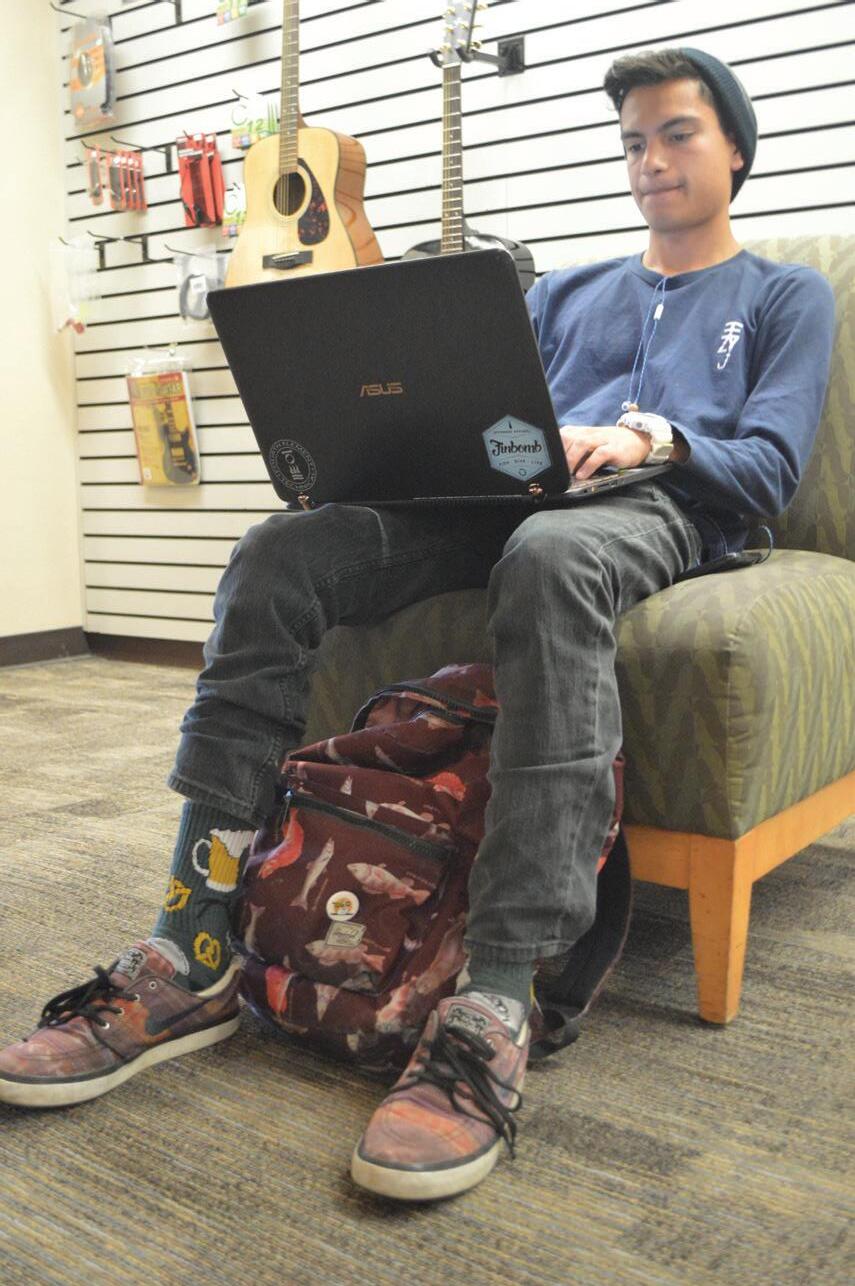
“I think they look cool, and they’re another way to style yourself. They’re an accessory,” he says.
Where does this young trendsetter find these statement socks? Johnson says he bought his funky socks on happysocks.com.
SPRING 2019 13
Art Watch
Cult to Culture: Surf Photography from the 1960s
STORY AND PHOTOS BY LESLIE VELIZ
Southern California in the 1960s was a medley of endless summers and subcultures, one of which was the budding surfing scene. “Cult to Culture,” now at the Long Beach Museum of Art, displays photographer LeRoy Grannis’s images and other objects from that era to explore the modest beginnings of surf culture, to its transformation into an international sport and ultimately, a lifestyle.
Grannis, or “Granny,” as he was later called, was born in 1917 and raised in Hermosa Beach. He learned to surf at 14 and did so until he enlisted in World War II. It was not until after the war, at the age of 42, that he began to delve into photography.
The exhibit features photos from Grannis’s hometown of Hermosa Beach, as well as Huntington Beach and Malibu. Some photos are even from Hawaii, as Grannis traveled with California surfers who went to the islands in search of massive waves. In order to take some of the photos, Grannis would join the surfers and take his camera in a wooden waterproof box. That box, Grannis’s cameras and other memorabilia are part of the exhibit, along with vintage surf magazines in which Grannis’s photos were featured.
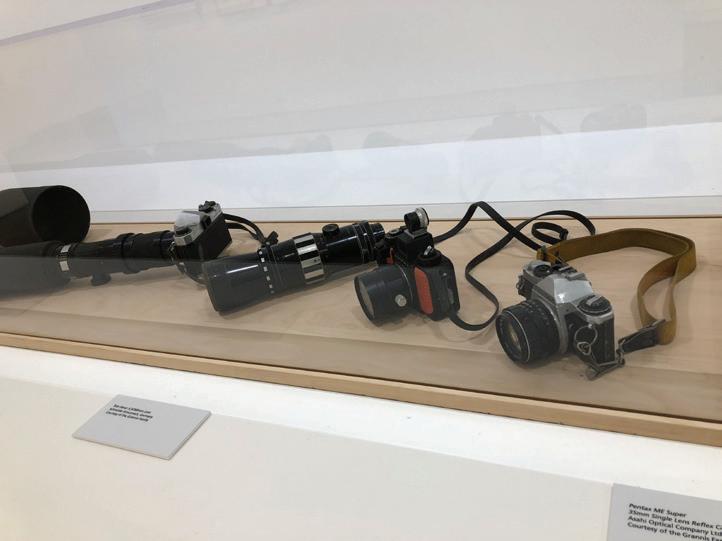


The photos are rich in color and ethereal; they capture the essence of Southern California beach culture. They evolve from locals surfing, to impressive surf competitions, to professionals riding the waves. The transformation from hobby to lifestyle is evident in Grannis’s photos.
The photos are not just of surfers, though. They include onlookers relishing the surfers and even some street photography. They evoke nostalgia for summer and for a time most of us weren’t alive to see. Grannis died in 2011, but his photos tell the story of a sport that became synonymous with Southern California.
“Cult To Culture” runs through April 21 at the Long Beach Museum of Art, 2300 E. Ocean Blvd., Long Beach, lbma.org.

14 SPRING 2019
Translating a Need
BY ROSLIN OJEDA
Problem-Solution
In October of 2017, the Clorinda Donato Center for Global Romance Languages and Translation Studies was established. The goal of the center is to connect students’ language abilities with a workable set of skills that will be appealing to employers. There is currently no other center like this in California. Dr. Donato is also in the process of establishing a minor in translation studies for Long Beach State students. We talked to her about the center and its plans for the future.
Q: WHAT EXACTLY IS TRANSLATION STUDIES?
A: Translation studies is what’s called “language provider services,” and it’s actually the fourth-largest growing industry in the United States. So many people in our country are multilingual, and many people and businesses need language services. This is where we come in. Language providers are in great demand, but the university doesn’t have a program that allows students to use their language and combine it with other skills that would then make them good candidates for these jobs. What companies need are people who can explain their products in different languages. This is what this kind of program prepares students for. There will also be many internships related to this. This is a wonderful opportunity for students with language skills who want to develop them in ways that really do match needs on the outside.
Q: WHAT IS THE IMPORTANCE OF KNOWING MULTIPLE LANGUAGES?
A: The importance of knowing multiple languages is the ability to work, communicate and exist in the increasingly multilingual and global marketplaces. For example, China has embraced translation as one of its most important priorities in their country. They know that in order to be a competitive country, they need to compete in multiple languages. What
this center also does is give heritage speakers the opportunity to take those skills, polish them up and use them to get themselves a great job and learn other languages and become multilingual, not just bilingual.
Q: WHERE DID THE FUNDS FOR THE CENTER COME FROM?
A: The center has been created with donor funds, in part. I also run the center for Italian studies, and one of the donors for the center wrote to me and said, “Could we maybe do something more? Something for all languages?” I said “Yes, why don’t we have a center for translation studies?”
Q: WHAT ARE YOUR HOPES FOR THE CENTER IN THE UPCOMING YEARS?
A: We hope to get as many students into it as possible in the upcoming semester so that we can start developing internships. The hope is to start spreading the word about the minor and the center to get the word out there that you have the opportunity to take this minor and combine it with any other thing you’re studying.
If you know and like languages, Dr. Donato invites you to visit her or email her at Clorinda.Donato@csulb.edu to learn about how to connect language with future employment.

SPRING 2019 15
Campus Events
Adventure Time
BY SARAH VEHRS
Students itching to get outdoors this semester can broaden their horizons with the Rock and Outdoor Adventures program offered by the Student Recreation and Wellness Center. Rock and Outdoor Adventures hosts half a dozen trips each semester, and anyone with a membership can sign up. The programs provide meals (tailored to dietary needs), transportation, instruction and equipment.
“Part of Rock and Outdoor Adventures’ mission is to offer people experiences they wouldn’t otherwise have, to broaden their college experience overall,” says Mikka Zanoria, the ROA student lead. “A lot of times, getting outdoors is hard and inaccessible because people don’t have the right gear or they don’t know what they’re doing or where they’re going or have friends to go with.
“This is a way to give people a bigger community of friends they haven’t met yet, as well as take them on new experiences.”
The next available trip is a hike to Black Star Canyon, in the hills of Orange County, on March 9. This is a moderate, 7-mile round-trip hike that includes scrambling over rocks and stream crossings. At the final destination, there’s an abandoned mine shaft and a waterfall. The deadline to sign up is March 6, and the cost is $30 for students, $60 for non-student members. Hikers will be provided with all the necessary gear.
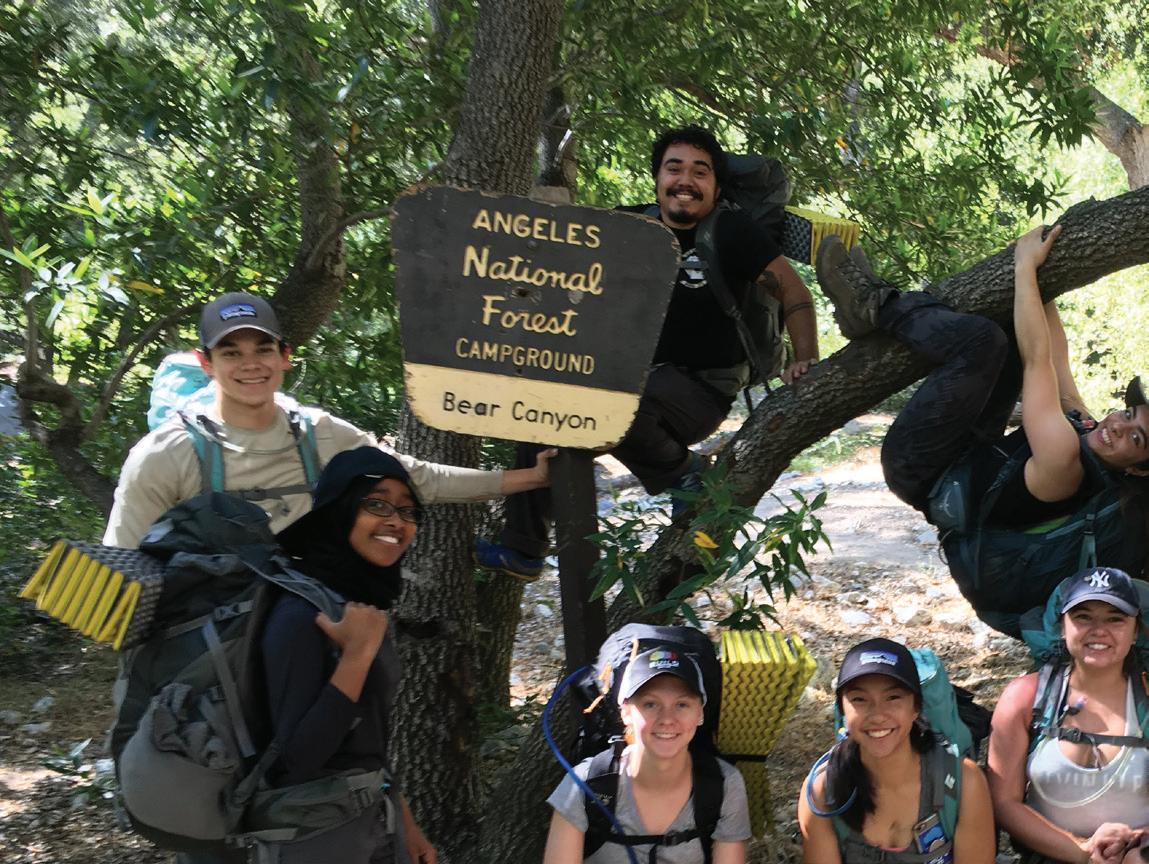

16 SPRING 2019
For a longer outdoor experience, members can sign up for the March 23-24 camping trip to Point Mugu. This is an overnight trip that allows people to hike through coastal mountain flora and fauna and pitch their tents to the sound of waves crashing on the nearby shore. The deadline to sign up is March 20 and the cost is $65 for students, $130 for non-student members.
Members looking to take it up a notch can sign up for the backpacking trip to Switzer Falls on April 13-14, a 9-mile round-trip excursion. On the first day, backpackers will hike 4.5 miles through Bear Canyon and Switzer Falls. There, they will set up camp and explore Angeles National Forest before they pack up and hike back the following day. The deadline to sign up is April 10, and the cost is $65 for students, $130 for nonstudent members. All equipment will be provided.

ROA will provide another day-trip hike on April 20, this time to Echo Mountain in San Gabriel National Forest. Hikers will get to see a unique relic from a time before cell phones, known as the Echo Phone: an old-fashioned metal megaphone secured to the ground that was used to shout messages to people across the mountain. The hike is 5.5 miles round-trip and includes a 1,600 foot elevation gain. The deadline to sign up is April 17, and the cost is $30 for students, $60 for non-student members.
The last ROA trip of the semester is the Crystal Cove Yoga Adventure on May 4, which will consist of yoga, exploring and hiking on the beach. The deadline to sign up is May 1, and the cost is $35 for students, $70 for non-student members.

SPRING 2019 17
A Report Card
BY LISSETTE MENDOZA-TAPIA
Hello Dysfunction (Podcast)

Childhood best friends Pata Fria and Crystal Barbie share the dysfunction in their lives and their outrageous knowledge and personal views on current events, mental illness, relationships, murder, family, sex, politics, the paranormal and parenthood. Say hello to your new best friends. Nothing is off limits, and everything is funny.
Trigger Warning with Killer Mike (Netflix Original Series)
This provocative six-episode docuseries features Atlanta rapper/activist Killer Mike, who puts his revolutionary ideas about achieving social change into action through radical social experiments. With episodes titled “Living Black,” “White Gang Privilege,” “New Jesus” and “Kill Your Master,” the series helped me regenerate some of my lost brain cells.
FYRE (Netflix Original Documentary)
Watch how what was supposed to be a once-in-a-lifetime concert on Pablo Escobar’s private island turns into a total barbaric disaster. Having a bad day? Hey, at least you weren’t one of the rich kids who got scammed over $12,000 into buying a ticket. While it’s entertaining in the beginning, it does start to drag halfway in. It’s one of those films where you actually have to pay attention to understand it.
7 Rings — Ariana Grande
Whether it was stealing the intro from The Sound of Music’s “My Favorite Things” or ripping off the flow from Soulja Boy’s “Pretty Boy Swag,” the pop princess did not win me over with her cute, but failed, attempt at rap. She needs to stick to hitting high notes on pop ballads and getting Japanese tattoos of small grills.
18 SPRING 2019 D
A B
Sweet Sandwiches
STORY AND PHOTOS BY MARIA MARTINEZ
LOLA’S MEXICAN CUISINE

4140 Atlantic Ave., Long Beach 2030 E. Fourth St., Long Beach lolasmexicancuisine.com
Get ready to spice up your next brunch! Lola’s Mexican Cuisine is a Long Beach local favorite, known for its concha breakfast sandwich, served only during weekend brunch. Mexican concha sweet bread is stuffed with scrambled eggs, bacon, and cheese and served with spiced potatoes for $10. When trying this savory take on a traditionally sweet sandwich, I went with an open mind. The bread itself was surprisingly soft and nicely toasted; it melted right in my mouth. The only downfall was too much egg. The concept was awesome, but I’m not sure I would eat it again. However, I would definitely go back for the bread and spiced potatoes.

HORCHATERIA RIO LUNA

15729 Downey Ave., Paramount horchateriarl.com
If you’re looking for a concha that will satisfy your sweet tooth, this is the place to go, known for its delicious traditional Mexican conchas, which are made fresh daily. The conchas are made-to-order with horchata ice cream in the middle and topped with a cajeta (caramel) drizzle and walnuts. Customers can choose between a regular concha ice cream sandwich ($5.25) or a large, which comes with with two scoops of ice cream, cajeta and walnuts ($7.25). I ordered the regular concha and added the drizzle and walnuts for the price of a large. This dessert was hands down the best thing I’ve ever tasted: the perfect combination.

DIG In SPRING 2019 19
Out With The Old, In With The
STORY BY LOLA OLVERA

Turning your clothing into cash
New
20 SPRING 2019
Of the many things that fill landfills, clothing is one of the most notorious.
According to The Balance Small Business, the people throw away around 80 pounds of clothing each year. We’re buying more clothing each year but only keeping them for half as long as we did 15 years ago.
Buying clothing second-hand has become the popular and eco-friendly solution touted by both environmentalists and hipsters. But buying secondhand is only half of the solution. Recycling your unwanted clothes is the other.
Once upon a time you could bring your items into a pawn shop or consignment store, but now, buy-selltrade stores are on the rise. Here, anyone can bring in their unwanted clothes and accessories to sell for cash or store credit. Even better for local Long Beach students, stores like Buffalo Exchange, Plato’s Closet and Tattered are only minutes away from campus.
Jazlyn Tabar, a sociology major at Long Beach State, has been working at the Buffalo Exchange on Second Street in Long Beach for nearly a year. She loves that her job entails “being around clothes, meeting new people, and building knowledge on different trends, styles and brands.”
As a buyer, she knows her stuff. She has to — buyers are the gatekeepers for the store’s curated selection of styles.
Presort your items!
At the buy counter, a trained buyer sorts through items and determines which ones they can take and how much they can price them for in the store. The seller has the option of taking a percentage of that price in cash (typically a third of the price) or store credit (typically half).
Buy-sell-trade stores are different from thrift stores in that they curate their selection, rather than just accepting donations. These shops pride themselves on stocking only the best styles in the best condition, at prices much lower than retail.
“A lot of styles come and go, but don’t bring in the camisoles and wrinkled skinny jeans you wore your freshman year of high school because we will most likely not take those!” Tabar says.
For buyers, it’s a great place to score a deal on trendy and unique items. For sellers, it’s a quick way to make some money off unwanted clothes.
“A lot of people sell clothes online now, but not everyone has the time to publicize their clothing and ship them out,” says Tabar. “Buffalo offers a really easy way to sell clothes while doing minimal work for it.”
Cleaning out your closet might be the hard part, but selling doesn’t have to be. Check out the tips below for getting the most out of your selling experience.
TIP$
Make sure to look through your items before bringing them in. No buy-sell-trade store will take in items that have tears, stains or fading. They only buy clothes that are in good condition.
Know the store.
Each buy-sell-trade store has its own personality. Plato’s Closet takes strictly current trends, Tattered takes more upscale styles and Buffalo Exchange sometimes takes unique or vintage items. Ask a buyer what they’re looking for or check out their online guides.
Consider store credit.
If you’re just trying to pay a phone bill, take the cash. But if you love shopping for clothes on the regular, take the store credit. Limit yourself to only buying clothing with what you made by selling; it’ll keep your shopping budget in check.
Recycle what’s left over.
Let’s say the buyer decided to pass on some of your items. Is that the end of the road for them? Nope! Keep them out of landfills by taking them to H&M, where you can get a 15 percent off coupon for donating your clothing for recycling. Yes, they’re purveyors of fast fashion, but it’s better than nothing.
SPRING 2019 21
A personal story of love and its effect on the human spirit
STORY BY PETE ESCOBAR
There’s this trope about love - that it can gift superpowers to mothers or fathers who need to help their children in dire situations. True or not, love can either guide one’s actions for the better or make one lose control. It’s the reason you’d drive hours just to get the chance to see a loved one again and it’s the reason you’d cry your eyes out at 3 a.m. in the pouring rain over someone. Whatever your take on love is, there’s almost no doubting that its power to affect the human spirit is immeasurable.
Growing up, things always felt off for me, like something was missing. It wasn’t until I started maturing that I realized exactly what that was: a relationship with my dad.

As a kid, I didn’t notice any sort of dysfunction in our family. I thought it was a normal thing for all fathers to sit around, smoke, drink and watch TV all day, like my father would. If I needed help, I’d turn to my mother, who was always there for me when she could be. The thought of going to my father in search of any sort of affection or help was daunting, like facing a giant who always had a beer in one hand and a remote in the other. Aside
from mandatory things, like picking me up from school, he kept himself out of my life.
My family put up with his complacency for a while, but he was unwilling to look for a job, and arguments between him and my mother increased. We eventually kicked him out, and for about two years he was absent from my life.
Finally having him gone felt like a blessing. There was no more household anxiety and no more stress on my mother or sister; we could live freely. Yondu, a character from Guardians of the Galaxy, said “He may have been your father, boy, but he wasn’t your daddy.” He never had an impact as a father, and I was ready to forget about him. And I did for those two years — until I found out he’d been hospitalized.
When I got the call from my mother, I wasn’t surprised to find out that he had cirrhosis of the liver as a result of years of alcohol abuse. He was in the ICU for emergency surgery when I first visited him. My family and I didn’t expect him to make it out alive; his liver was badly damaged, and he had a variety of other things wrong with him, all of which sounded like medical jargon.
22 SPRING 2019
But by luck, divine intervention or doctoral expertise, he made it out alive. And for the first time in what was probably decades, he didn’t have any alcohol in his system.
I never thought my father loved me. Not because of anything he did, but because of all the things he didn’t do. It was only a few days before he died that I realized he did love me and my family.
That day, I was having trouble with my car — the starter, to be exact — but at the time I didn’t know what the problem was. When my dad heard me complaining about it not igniting properly, he was vocal about wanting to get up and look at it.
“Come over here and help me,” he said, as he struggled to get out of his bed. I was nervous at first. He didn’t have any strength after undergoing surgery. He was skinny, pale and needed help walking, but he still insisted. It was the longest walk of my life. Every few moments, he needed to take a break, and when I looked over at him, his eyes were wide open and bloodshot, and he was shaking. But I only saw him looking at my car, wanting to help in any way that he could, so we persisted.
I know as much about cars as an ape, but my dad was a former mechanic, so if something was off, he could spot it. I popped my hood open, and he began checking everything, from the battery to a bunch of other components that I couldn’t name. He couldn’t find the problem, and I knew he was disappointed in himself, but I didn’t care. All I could think about was how insane it was for someone in his condition to be doing a mechanic’s work.
A few days later, December 12, was when he passed. I remember my mom calling for my help. My father had fallen in the bathroom, either from passing out or simply falling; we’re still not sure. He was too weak to stand or walk, so we carried him to the bed we had set up in the living room. He was in pain but insisted that he was OK.
My sister, mother and I were by his bed, and he kept asking us to hold him. “Pete,
come here, hold me, son,” words I never expected to come from him. I think he knew his time was slipping, but we didn’t. And if I had known that he would suffer a heart attack by the time I got back from picking something up from the store for him, I never would have left.

In the chaos of everything that transpired before I had gone, he may or may not have murmured the words “I love you” to me, but I simply cannot remember. I know of only one human element that can make people perform incredible feats in dire situations, and that is love. My dad didn’t lift up my car like Superman, but he found the strength he needed to push through his own pain and help me with my car troubles. He sat on his bed asking for us to hold him, not from the
fear of death, but from the warmth of love.
After his death, I found out a lot about my father from former friends and neighbors of his. His home life was a lot worse than mine. His own father had scarred him emotionally, and that had an impact on how he raised my family. Alcohol may have been his only escape from his own pain.
Is it an excuse for the way he treated my family? I’m not sure — it is still something that I contemplate today. But knowing that love is what pulled him out of the caverns of his own darkness and into my family’s hearts gives me comfort. Love is a tricky little thing, but it can give us the strength we need to push on.
SPRING 2019 23
“I know of only one human element that can make people perform incredible feats in dire situations, and that is love.”
Support In Times of Need: The New Face of FUEL
STORY BY ISAURA ACEVES

The current administration has set an aggressive agenda on many immigration policies such as the attempt to end the Deferred Action for Childhood Arrivals program and the “zero tolerance” policy enforced last May. There is a constant uncertainty on what may happen to undocumented students, but there’s a group on campus that hopes to reassure them that they are not alone.
The student organization For Undocumented Empowered Leaders, otherwise known as FUEL, advocates, educates and empowers the undocumented community at Long Beach State. It hopes to provide a safe space for all undocumented students, including AB 540 students, DACA students, and those who don’t qualify for DACA. FUEL advocates for their rights through rallies, forums and much more.
“We mostly provide support in terms of getting them information on what resources are on campus,” said FUEL’s student president, Stephanie Medina.
The organization was founded in 2007 and was pivotal in the foundation of the Dream Success Center. FUEL provides connections to scholarships from the center, relays information
24 SPRING 2019
on upcoming workshops on campus, assists with DACA application renewal, and provides a safe space to vent frustrations.
“If our members just want to vent, we’re here to listen to them,” Medina says. “If they just want to talk to other people who fall under the same identity as undocumented or AB 540, that’s what we’re here for as well.”
The organization was renamed from Future Underrepresented Educated Leaders to For Undocumented Empowered Leaders because new student officers wanted to clearly state their purpose: The organization is for undocumented students on campus. They want to empower undocumented student leaders at the university and make sure they have support behind them. This goal has humbled vice president Dulce Hernandez, who came to understand how essential the organization is for her and others like her.
“To me, having a space where other undocumented [students] can come and feel like they have somebody makes me feel like I’m doing something good...It’s not just about me, it’s about us,” Hernandez says.
For many, FUEL is not only a resource, but also a family. Member Maricarmen Hernandez joined the organization this fall and discovered a kinship unlike anything she’s experienced before. As she faced tension with immigration policies and the process of renewing her DACA application, she felt isolated among friends who didn’t have the same experiences.
“I love Wednesdays because I get to come here,” she says. “It feels like a family. It’s a lot of helping each other out and stuff. I [just] love coming here and talking to everyone.”
For many like Maricarmen Hernandez, FUEL became a place to meet and feel reassured despite the current political climate. The organization has helped relieve some of their frustrations, and they’ve grown a strong support system where they can face the unpredictable future together as a unit.

“When Trump...barely got elected…[I]
was just kind of dealing with it on my own,” Maricarmen Hernandez says. “Something’s always going to happen, [but] we’re going to have a place here and we’re together and we’re all going to fight.”
Undocumented students face many stressors in their daily lives, from worrying about their status and their families to what’s going to happen next with the administration. As uncertain as everything may be, this doesn’t stop them from ensuring their voices are heard.
“You know we’re undocumented and we’re unafraid,” Medina says. “We’re coming out of the shadows. A lot of us are not scared anymore or were never scared.”
FUEL is working to create more events in the future for students to participate in and to create change on campus. At their meetings, they discuss issues where they see a need for changes to accommodate undocumented students.
One of the major changes they would like to see includes changing the name of the Dream Success Center. The term “Dreamer” refers to the Dream Act of 2001 that granted legal status to undocumented immigrants who were brought to the United States as children and went to school here. However, it isn’t one that many find appropriate to describe themselves.
“‘Dreamer’ is a term that gets used way too much by legislative [bodies]...to profit off of us,” Dulce Hernandez says. “We don’t want to settle for just the Dream Act, we want more, and we don’t want more just for us—more for everybody, for our parents and those not under DACA.”
Another change they’re fighting for is a free immigration lawyer on campus who will consult with undocumented students at the Dream Success Center. Undocumented students don’t qualify for Federal WorkStudy. They hope to find a solution for more funding and opportunities for students to work on campus.
“I want [undocumented students] to know and I want them to be aware that their voices are heard. And we hear them,” Medina says.
SPRING 2019 25
EXCERPTS FROM SATURDAZED
 PHOTOS BY ANDRES TOLENTINO
PHOTOS BY ANDRES TOLENTINO
These photos are featured in Tolentino’s photography book, SATURDAZED. Each photo vividly emphasizes color, contributing to the psychedelic visuals and feel of the book as a whole. Tolentino is a photography student at Long Beach State and the photo editor for DIG MAG.


26 SPRING 2019
A Creative Life
STORY AND PHOTOS BY GILLIAN SMIT

In order to preserve the legacy of the past and continue to advance art in modern culture, new generations of artists must refine their craft and share their talents. It sounds glamorous, this ability to contribute to the continuation of one of the oldest aspects of human nature and culture. But the arts are challenging fields of work and study. They are competitive and require talent, determination, perseverance and a strong work ethic. They do not hold any guarantee of success or financial stability.
Despite these challenges, young people of all specializations — music, dance, theater, drawing, animation, creative writing — continue to pursue careers in the arts. I met with four of them to observe their art form in action and understand why they are studying the arts.
SPRING 2019 27
Maylin Guida, 20, is a third-year English creative writing major at Long Beach State. Though she primarily writes short stories in her creative writing classes, she prefers working on the several young adult novels she is writing.


“I write fiction because it is my way of expressing myself and engaging with inspiration and creativity,” Guida says. “I love creating characters and the worlds in which they live and seeing what has previously only been in my head come to life on the page.”

28 SPRING 2019
Grace Sledd is a second-year music education and classical flute performance double major at Long Beach State, where she also works as a residential assistant in the Hillside dormitories. Though Sledd specializes in flute, she recently learned piccolo to fill a vacancy in a student ensemble. As a music education major, Sledd is learning to play all of the instruments that comprise a standard concert band and orchestra, from percussion to brass instruments.
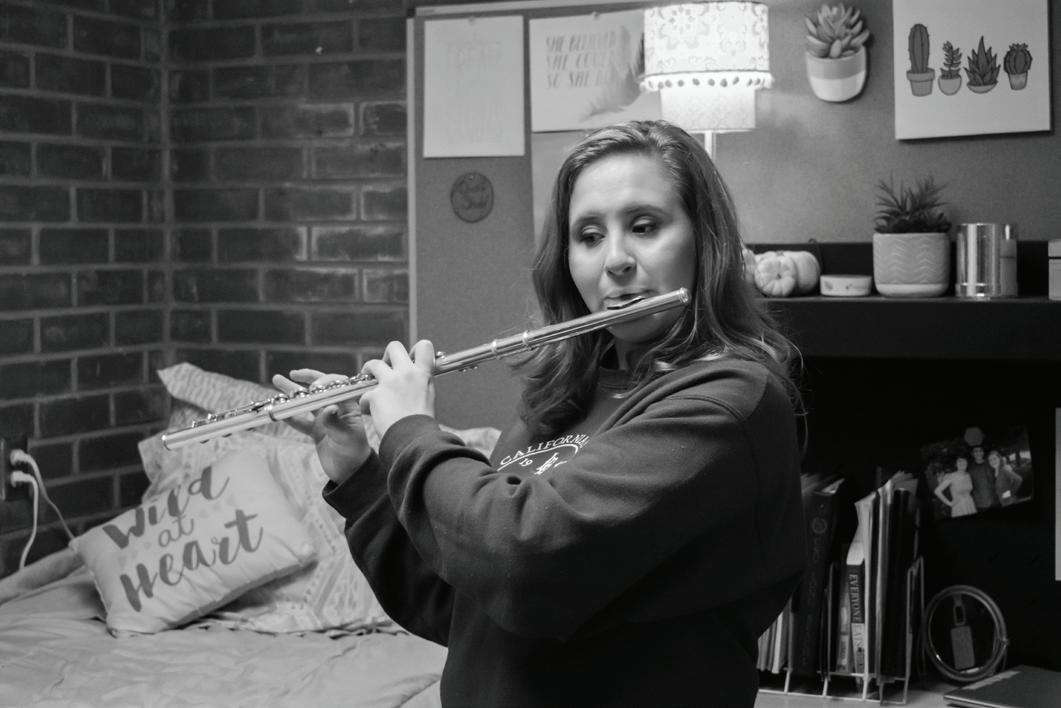

“I am studying music because music is the most important thing in my life,” Sledd says. “Music is my passion, and I will continue to make and teach music for the rest of my life.”

SPRING 2019 29
Keely, 20, is a second-year art major at Long Beach State studying animation and illustration. Their passion for storytelling, evident in their long-time hobby of creative writing, gives them the inspiration to design characters, settings and storyboards.


“Part of why I’m at Cal State Long Beach is because the illustration department is so closely linked with the animation department,” Keely says. “I want to tell some cool stories and I want to use moving pictures to do it.”

30 SPRING 2019
Donovann Smit, 16, is a sophomore at Western Sierra Collegiate Academy, a charter high school in Rocklin, California. He participates in two musicals each year with a youth community theater company and is in his second year of competitive show choir at his high school. Smit has been taking dance classes since age 12 and has been singing in school and community performances since he was 7 years old.


“Theater is a way for me to show the other side of me,” Smit says. “Instead of being this introvert who doesn’t always know what to say, I can be funny and comfortable during rehearsals and on stage. I love the community of people that theater creates.”

SPRING 2019 31


32


@DIGMAG
follow us
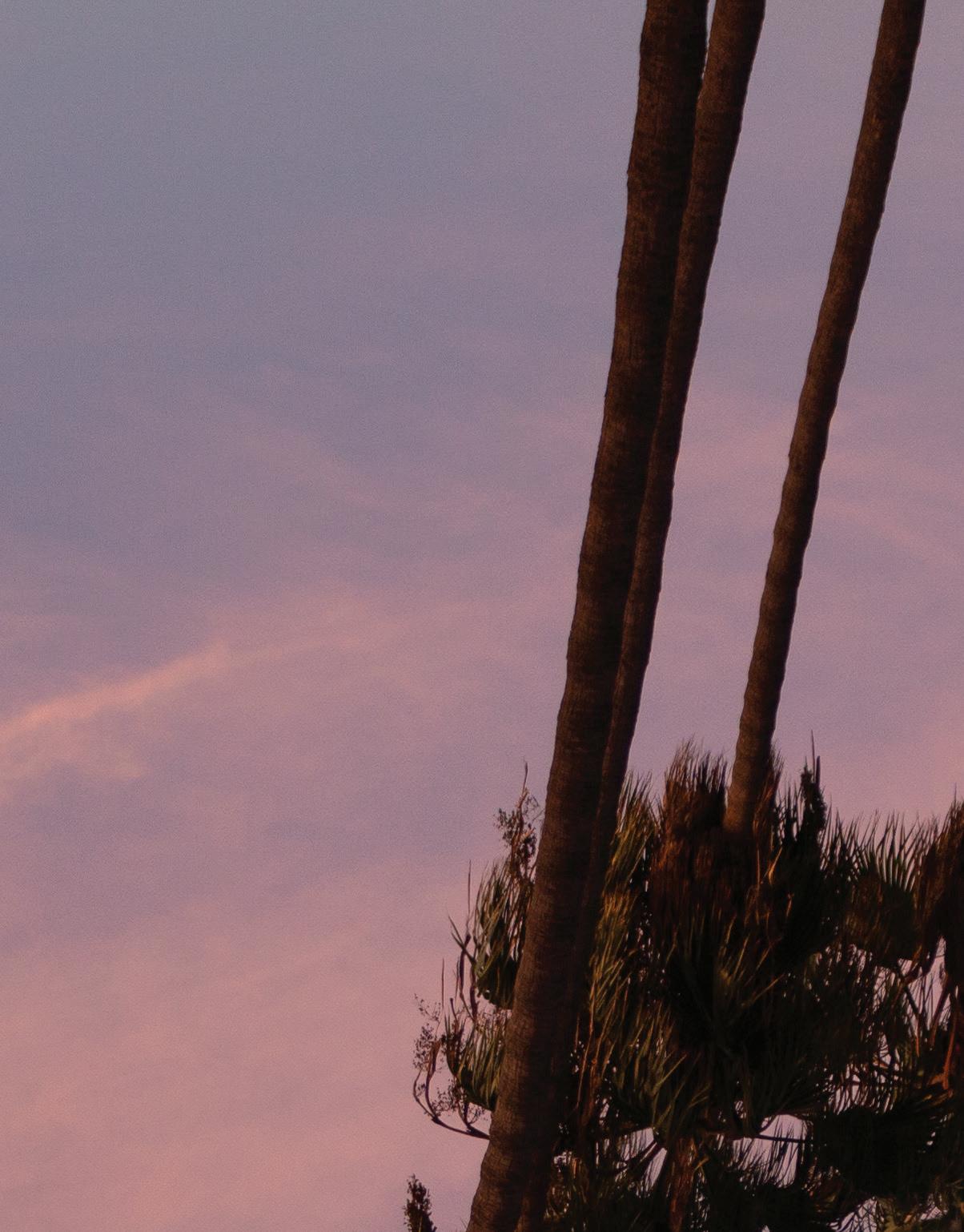






















 BY JORGE PANIAGUA
BY JORGE PANIAGUA





































 PHOTOS BY ANDRES TOLENTINO
PHOTOS BY ANDRES TOLENTINO

















